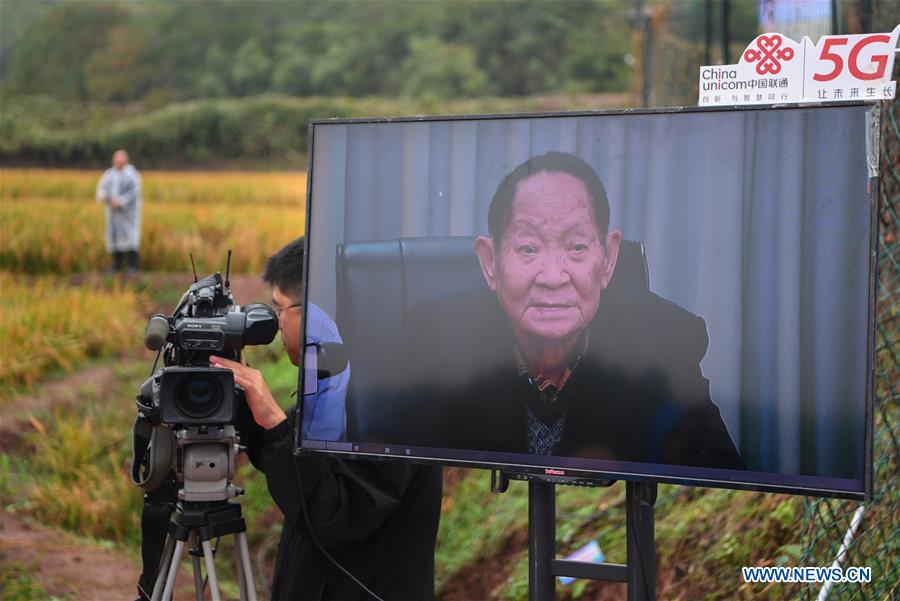Third-generation hybrid rice achieves high yield

Yuan Longping, the "father of hybrid rice", is seen on a screen during video link at an experimental demonstration field in Hengnan County, central China's Hunan Province, Nov. 2, 2020. The third-generation hybrid rice developed by Yuan Longping, the "father of hybrid rice," and his team achieved a yield of 911.7 kg per mu (about 667 square meters) in an experiment in central China's Hunan Province. [Xinhua/Chen Zeguo]
CHANGSHA -- The third-generation hybrid rice developed by Yuan Longping, the "father of hybrid rice," and his team achieved a yield of 911.7 kg per mu (about 667 square meters) in an experiment in central China's Hunan Province.
"I would be very happy if it exceeds 880 kg. Now it exceeded 900 kg, I am extremely happy," Yuan said after the yield was announced Monday.
Plus an early season rice yield of 619.06 kg, the same plot in Qingzhu Village, Hengnan County, has produced a yield of 1,530.76 kg per mu in a year. The output is equivalent to 22.96 tonnes per hectare.
Last year, the same late hybrid rice variety, "sanyou No.1", made a single-cropping yield of 1,046.3 kg per mu on the same plot.
Hunan is a major rice producer in China, where farmers plant double-cropping rice.
"High yield and resistance to disease, cold and lodging are the advantages of the third generation hybrid rice, compared with the previous two generations," said Li Xinqi, a researcher at Hunan Hybrid Rice Research Center and host of the third-generation hybrid rice project.
This year's high yield of the double-cropping rice has been made under unfavorable conditions of low temperature and shorter durations of sunlight, Li said.
Li Qiusheng, an agronomist with the agriculture and rural affairs bureau in Hengnan County, said that according to meteorological data during the critical period of rice growth, 43.85 effective sunshine hours were recorded this year, compared to 187.8 last year.
"The village was not particularly chosen for the test of the new generation hybrid rice. Besides, the rice did not receive any special care, which is not much different from normal farming by ordinary farmers," Li said.
Under similar conditions, yields of local double-cropping rice averaged between 700 kg and 800 kg per mu, while the new hybrid rice exceeded 1,500 kg per mu.
Li Jianwu, an expert with the Hunan Hybrid Rice Research Center, said the expert team had visited the experimental fields only twice from sowing to harvesting, in contrast to the long-term guidance rendered to rice farmers in the past.
"The most prominent feature of the third-generation hybrid rice is that it gives a full play to the advantages of hybridization. Its own vitality can help save farmers' cost and labor," he said.
China now feeds around 20 percent of the world's population, with less than 9 percent of the world's arable land.
Yuan, who developed the world's first hybrid rice in the 1970s, has set multiple world records in hybrid rice yields in previous years, making great contributions to the food security of China and the world.
Yuan's team is still working on the third-generation hybrid rice combinations and conducting studies for the simplified cultivation of the rice, aiming at high yields with less use of fertilizers.
Yuan said he wants to ensure the third-generation hybrid rice variety boasts "the comprehensive strength to promote a greener and more sustainable development of China's rice production with higher quality and yield."
























